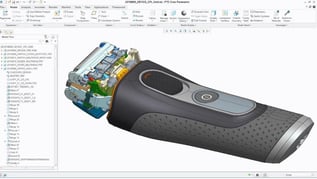 Where do you stand on the parametric vs. direct modelling debate? For some design engineers, the openness and flexibility of direct modelling makes it the ideal design tool. Others, however, prefer the control that comes with using a parametric approach.
Where do you stand on the parametric vs. direct modelling debate? For some design engineers, the openness and flexibility of direct modelling makes it the ideal design tool. Others, however, prefer the control that comes with using a parametric approach.
For many, the value of direct modelling is the ability to capture and record new geometry quickly, without having to worry about constraints associated with parametric modelling. On the other hand, by using parametric modelling technology, users are able to capture full design intent with the features and constraints that make it possible to automate repetitive changes.
So is one better than the other? In truth both direct and parametric modelling have pros and cons. For many, if not most users, the best approach comes from a combination of direct and parametric technology. In fact, by integrating a direct modelling approach into your parametric environment, then you can access the best of both worlds.
What are the advantages and disadvantages of parametric modelling?
For a start, parametric modelling is a great approach when it comes to design tasks that involve exacting requirements and manufacturing criteria. This could include cases where companies produce a range or family of products that only have minor variations. With parametric modelling, the designer has the ability to:
- Make automatic updates to the model if changes are made to the design
- The ability to easily capture design intent, which makes it easier to define how the model should behave when something is changed.
- Easy definition and automatic creation of families of parts
- Strong integration with the overall manufacturing process, which leads to a reduction in production times
However parametric modelling is not without technology is not without some disadvantages. The main limitations that are associated with parametric modelling are:
- For many, parametric tools are too heavy handed for concept design work, especially when waning to explore as many options as you can
- If there are any late-stage or unexpected design changes, then parametric models take longer to amend and update
What about the advantages and disadvantages of direct modelling?
When it comes to direct modelling, it creates geometry rather than features. This is ideal for concept design work, where designers want to be able to explore a wide range of ideas without being limited.
A direct modelling approach is all about having speed and agility in the design process. It also means:
- Being able to make new 3D models very quikly
- Being able to make edits and amends with ease
So what are the downsides? In contrast to parametric modelling, direct struggles with:
- Little to no design automation
- Weaker dimension-driven editing
What does this mean for users?
In essence, the pros and cons of direct and parametric modelling mean that the ideal solution for product design is a blended approach. It means being able to take the advantages of both approaches, without having to worry about being limited by their cons.
To find out more, take a free 30-day Creo trial today
